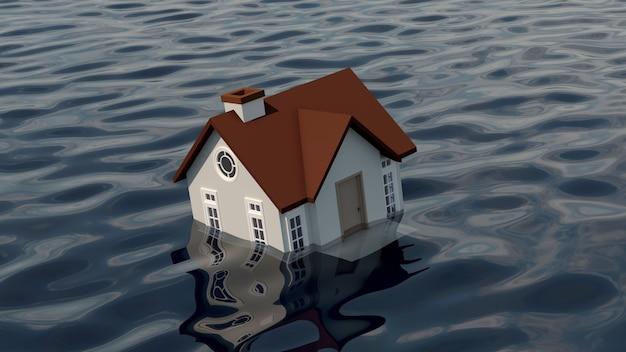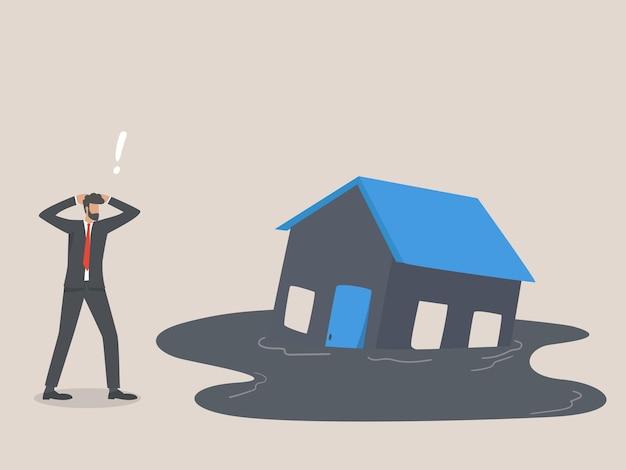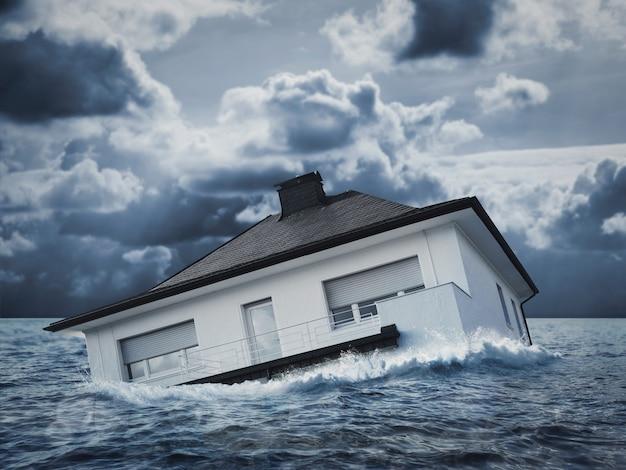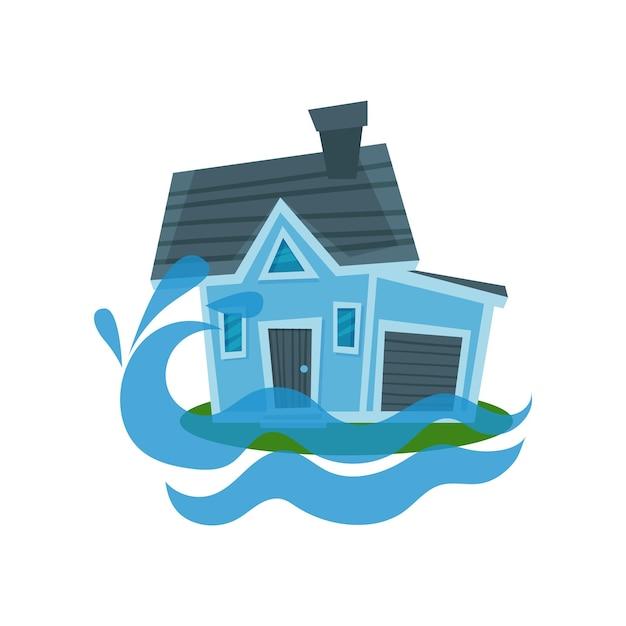You wake up one day to realize that one corner of your house is sinking. Panic sets in, and you start wondering what to do or who to call. No one wants to be in such a situation, but unfortunately, it happens. A sinking house is a problem that affects many homeowners, and it can have devastating consequences if not addressed promptly.
Some homeowners assume that a sinking house is a normal occurrence that doesn’t require attention. However, ignoring the problem can lead to severe structural damage, resulting in expensive repairs. If you’re reading this, chances are you’re experiencing a sinking house, or you want to learn more about this issue.
In this comprehensive blog post, we’ll cover everything you need to know about a sinking house. We’ll discuss the signs to watch out for, the repair costs, and how to deal with your insurance company. We’ll also highlight some of the causes of a sinking house, how you can prevent it, and when to call a professional. By the end of this post, you’ll have a clear understanding of how to deal with a sinking house and save yourself from significant losses.
Sinking House Repair Cost
If you suspect that your house is sinking, it’s essential to take immediate action to prevent catastrophic damage. Repairing a sinking house can come with a hefty price tag, but it’s a necessary expense to maintain the structural integrity of your home. Here are some factors that may affect sinking house repair cost:
Inspection Cost
Before beginning any repair work, you’ll need to hire a professional inspector to assess the severity of the damage. An inspector may charge anywhere between $300 to $1,000, depending on the size of the property and the extent of the damage.
Type of Foundation
Different types of foundations require different repair methods. The cost of repairs also varies depending on the type of foundation your home has. Here’s how much you can expect to pay for repairs depending on the type of foundation:
- Pier and Beam Foundation – This is the most affordable type of foundation to repair. Expect to pay anywhere between $2,000 to $7,000.
- Slab Foundation – This is the most common type of foundation in Houston. Repairing a slab foundation can be expensive, ranging from $10,000 to $20,000.
- Basement Foundation – This is the most expensive type of foundation to repair, primarily because of the waterproofing required. Do not be surprised if the cost of a basement foundation repair exceeds $40,000.
Extent of Damage
The extent of the damage will directly affect the repair cost. For minor sinking issues, repairs can cost as low as $500, while major sinking problems can cost upwards of $100,000 or more. Factors that affect the extent of the damage include the soil type, water damage, and the age of the house.
Repair Method
There are several repair methods that contractors may use to fix a sinking house. The repair method used can also impact the total cost. For instance, injecting material under the foundation can cost between $2,000 to $10,000, while installing steel piers can cost between $5,000 to $15,000.
Sinking house repair cost is a significant expense that homeowners in Houston should take seriously. The cost of repairs depends on several factors, but hiring a professional inspector is the first step in knowing how much you’ll need to pay. It’s always better to address the issue early on before it becomes more severe and more expensive to repair.
Signs Your House is Sinking
If you’re worried about your house sinking, it’s best to catch the signs early. Here are a few things to look out for:
Cracks
Check for cracks on the walls, floors, and foundation. Cracks that are wider than a quarter of an inch could indicate structural issues and could be a sign your house is sinking.
Uneven floors
If you notice that your floors are uneven or sloping in one direction, you should get it checked out. This could be a sign of foundation settling or sinking.
Doors and windows that don’t close
If your doors and windows suddenly start to stick or won’t close properly, it could be a sign that your house is sinking and the foundation is shifting.
Leaning chimney
If you have a chimney, you should keep an eye on it for any signs that it’s leaning. This could be a sign that the foundation is sinking or shifting.
Water damage
If you notice any water damage around your house, it could be a sign that the foundation has shifted and caused pipes to break. Look out for water marks, bulges, or warping.
Sagging roof
If your roof is sagging or dipping in one area, it could be a sign that the foundation is shifting or sinking. This is a serious issue and should be addressed as soon as possible.
If you notice any of these signs in your home, it’s important to get it checked out by a professional. Early detection can save you a lot of money and headaches in the long run. Don’t hesitate to take action and get your house back to being safe and secure.
What to Do If Your House Is Sinking: One Corner of the House Sinking
If you notice that one corner of your house is sinking, don’t panic. Here are some things you can do to assess the situation and resolve the issue:
Check for Warning Signs
Before taking any action, it’s essential to identify the warning signs of a sinking foundation. Here are some things you can look for:
- Uneven floors
- Cracks in the walls
- Doors and windows that don’t close properly
- Gaps between the walls and the ceiling
- Sloping floors
If you notice any of these signs, it could indicate that your house is sinking, and you need to take immediate action.
Identify the Cause
Identifying the cause of the sinking is crucial. Here are some reasons why one corner of your house could be sinking:
- Soil erosion
- Poor soil compaction during construction
- Water damage
- Plumbing leaks
- Poor foundation design
Ensure you understand the cause of the sinking to implement the right solution.
Call a Professional to Assess the Situation
Don’t try to fix the issue yourself. You may end up making the situation worse. Instead, call a professional foundation contractor or structural engineer to assess the problem’s severity. The professional will determine the extent of the damage and recommend the most appropriate remedy.
Repair the Foundation
After identifying the cause and extent of the sinking, the professional will recommend the appropriate repair method. Here are some solutions:
- Installing piers or underpinning systems to lift the foundation
- Mudjacking or slabjacking to raise the concrete slab
- Drainage correction to reroute water away from the foundation
- Reinforcing the foundation with steel or concrete beams
The method of repair will depend on the underlying cause and severity of the sinking.
Prevent Future Sinking
After repairing the foundation, it’s essential to prevent future sinking. Here are some ways to do this:
- Regularly inspect your house for signs of sinking
- Maintain proper drainage around your house
- Control water runoff from your roof
- Properly maintain your plumbing systems
- Consult a professional for more advice on how to prevent future sinking
In conclusion, if you notice one corner of your house sinking, don’t ignore it. Instead, take immediate action by identifying the warning signs, identifying the cause, calling a professional, repairing the foundation, and taking steps to prevent future sinking.
My House is Sinking on One Side
If you notice that your house is sinking on one side, it could be a sign of a serious structural problem that requires urgent attention. Here are some things you can do to mitigate the damage and prevent further sinking:
Check the Foundation
The foundation of your house is the base that holds everything up. If it is compromised, it can cause the house to sink on one side. Check your foundation for cracks, settling, or any other signs of damage.
Look for Signs of Water Damage
Water damage can also cause your house to sink on one side. Look for signs of water damage such as warped floors, damp walls, or mold growth. If you find any of these signs, you should address the issue immediately to avoid further damage.
Inspect the Soil
Soil erosion or instability can cause your house to sink on one side. Inspect the soil around your foundation and look for signs of sinking or settling. Check for trees or bushes growing too close to your house, as their roots can cause soil disturbance.
Consult a Professional
If you are not sure what is causing your house to sink on one side, it is best to consult a professional. Contact a structural engineer or a house leveling contractor to assess the situation and provide a solution.
Key Takeaways
- Check your foundation for damage
- Look for signs of water damage
- Inspect the soil around your home
- Consult a professional if you are unsure of the cause
In conclusion, if you notice that your house is sinking on one side, it is crucial to take action immediately. Ignoring the problem can lead to costly repairs down the line. Check for signs of damage, inspect your soil, and consult a professional if necessary. By taking these steps, you can prevent further damage and keep your home safe and secure.
Is it Normal for a House to Sink
It’s easy to assume that a sinking house isn’t normal because no one expects their home to start sinking. However, the truth is that some level of sinking is normal and expected. It’s called settling, and it’s a natural process that happens to almost every home. Here’s what you need to know about whether your house sinking is normal or not:
What is settling
Settling is the process by which a house sinks into the ground as the soil beneath it compresses. This is a natural process that happens to almost every house over time. It’s usually not something to worry about unless it becomes excessive.
How much settling is normal
Some settling is normal and to be expected in any house. In fact, many houses will settle up to two inches in the first few years after construction. Usually, this settling isn’t a problem unless it’s uneven, which can cause structural issues.
How can you tell if your house is sinking
Here are some signs to look out for if you suspect your house is sinking:
- Cracks in the walls and ceilings
- Doors and windows that won’t close properly
- Sloping floors
- Gaps between the walls and ceiling or floor
If you notice any of these signs, it’s a good idea to have a professional come in and assess the situation.
When is sinking not normal
While settling is normal, sinking can become a serious issue if it’s excessive or uneven. Here are some situations where sinking is not normal:
- If the sinking is causing structural damage to your home.
- If the sinking is causing significant cracks in your walls or foundation.
- If the sinking is causing doors and windows to become misaligned and difficult to open.
If you’re experiencing any of these issues, it’s important to have a professional evaluate the situation.
In conclusion, some level of sinking is normal and to be expected in any house. Settling is a natural process that happens as the soil beneath your house compresses. However, sinking can become an issue if it’s excessive or uneven. If you suspect that your house is sinking, be on the lookout for signs of structural damage, and consider having a professional assess the situation.
What to Do If Your House Is Sinking
Is House Sinking Covered by Insurance
If you find out that your house is sinking, one of the biggest concerns you might have is whether or not it’s covered by insurance. Here are some important things to keep in mind:
- Insurance policies differ depending on the provider and the type of coverage you have, so you need to check your policy’s terms and conditions to see whether they cover your home’s sinking.
- In general, damage caused by natural disasters like earthquakes or landslides is not usually covered by standard homeowner’s insurance policies.
- Some insurance policies may cover the damage caused by sinkholes or foundation issues, but it’s essential to check with your insurance provider to confirm.
- If you have flood insurance, it may cover the damage caused by foundation problems resulting from ground movement because of flooding.
In conclusion, if you suspect that your home’s sinking may be due to a covered event or if you’re unsure whether your policy would cover the damage, speak with your insurance provider to confirm your coverage.
What to Do If Your Insurance Doesn’t Cover House Sinking
If your house is sinking, and your insurance policy does not cover it, don’t panic. Here’s what you should do:
- Hire a professional engineer or home inspector to assess the damage and determine the cause of the sinking. This step helps you understand the severity of the issue and unveils the best next steps to take.
- Once you have a report from the engineer or home inspector, which confirms that your home is sinking, seek quotes from several contractors for repairs.
- Speak to your mortgage provider to determine whether they can provide any assistance or if you can access any home equity loans or lines of credit to help pay for repairs.
- Depending on the severity of the sinking and your financial situation, it may be necessary to consider moving out of your home until the issue resolves.
It’s understandable that finding out your house is sinking can be overwhelming, but remember that there are options available to you even if your insurance policy doesn’t cover the damage. By following the steps outlined above, you can take positive steps to address the issue and begin the process of repairing your home.
Key Takeaways
- Insurance coverage differs depending on policy terms and conditions.
- Earthquake damage and other types of natural disasters are usually not covered in standard homeowner’s policies.
- Flood insurance may cover the sinking of your home, depending on the severity.
- If your insurance doesn’t cover the damage of a sinking home, hire a professional to assess the damage, speak to your mortgage provider about assistance, and consider moving out until the issue is resolved.
What Happens When Your Foundation Sinks
When your foundation sinks, it can have significant consequences for both your home and your wallet. Here are some of the most common issues you might face:
Cracks in Walls and Floors
One of the most visible signs of a sinking foundation is cracks in walls and floors. Initially, these cracks may be small and mostly cosmetic, but if left untreated, they can grow in size and begin to affect the structural integrity of your home.
Uneven Floors
If your foundation sinks in one area more than others, it can cause your floors to become uneven. This can make it difficult to walk around your home, and it may also indicate that your foundation is severely compromised.
Difficulty Opening and Closing Doors and Windows
As your foundation sinks, it can cause your doors and windows to become misaligned. This can make it difficult to open and close them, and it can also compromise the security of your home.
Plumbing Issues
A sinking foundation can also cause problems with your plumbing. If your foundation sinks, it can cause your pipes to become misaligned or even break, resulting in leaks and water damage.
Decreased Property Value
If your foundation sinks, it can significantly decrease the value of your home. Potential buyers may be hesitant to purchase a home with foundation issues, and if you ever decide to sell your home, you may have to settle for a lower price.
Expensive Repairs
Repairing a sinking foundation can be a costly and extensive process. Depending on the severity of the problem, you may need to have piers installed to lift and stabilize your foundation. Additionally, you may need to repair any damage that has been caused by the sinking foundation, such as cracks in walls and floors.
In summary, a sinking foundation can cause a range of issues for your home and your wallet. If you suspect that your foundation is sinking, it’s essential to take action as soon as possible to prevent further damage.
Why Is the Ground Sinking Around My House
If you notice that the ground around your house is sinking, it could be a sign of an underlying issue that needs to be addressed. Here are some reasons why the ground may be sinking around your house:
Soil Erosion
Soil erosion happens when the soil around your home is washed away, leaving space for the ground to sink. This can happen due to rainfall, flooding, or poor drainage around your home. Soil erosion can also occur due to the removal of trees or other plants that protect the soil from water damage.
Weak Soil Structure
If the soil beneath your home is weak, it may not be able to support the weight of your house, causing the ground to sink. This may happen if your home was built on soil that has a high clay content or is too sandy. In some cases, the soil may be naturally unstable, leading to sinking.
Underground Pipe Leaks
If you have underground pipes that are leaking, it can cause the soil around your home to become saturated and weaken, leading to sinking. This can happen with water supply lines, sewer lines, or sprinkler systems.
Faulty Foundation
If your home’s foundation is not properly built or has been damaged, it can lead to sinking. A cracked or damaged foundation can cause the house to shift, which can lead to sinking in some areas.
Natural Settling
All homes experience some natural settling over time, which can cause the ground to sink in some areas. This is typically not a cause for concern unless it is excessive or uneven.
In conclusion, the sinking of the ground around your house can be due to various factors. If you notice any signs of sinking, it is essential to take action promptly to address the issue before it becomes more severe.
When Should I Worry About My House Settling
If you’re a homeowner, it’s natural to be concerned about your property’s stability. After all, your home is likely the most significant investment you’ll make in your lifetime. So, it’s essential to be aware of the signs that your house is sinking or settling and when you should start to worry.
Here are some indications that your house might be sinking and you need to get it checked out by a professional:
Significant Cracks
If you notice significant cracks in the walls, especially near the doors and windows, it could be a sign that something is wrong with the foundation. These cracks might be more than just cosmetic blemishes; they could indicate a more severe structural issue.
Doors And Windows Not Opening
If doors and windows that used to open and close smoothly now stick and are difficult to open, it’s another sign that your foundation might be sinking. This issue is especially prevalent in older homes. Swelling and contracting of the soil beneath the foundation can cause it to shift, leading to warped and misaligned doors and windows.
Uneven Flooring
Uneven flooring is prevalent in homes that have an unstable foundation. As the foundation shifts, it can cause the floors to become uneven and slope in different directions.
Sagging Roof
Sagging roofs are a clear indication that something is structurally wrong with your home. If your roof starts to sag, it could be because of severe foundation damage.
Plumbing Issues
If you notice that your pipes are making strange sounds, or you’re experiencing slow drainage, it could be a sign that your plumbing is being affected by your foundation. As the foundation sinks, it can cause pipes to shift and become misaligned, leading to blockages and other plumbing issues.
It’s essential to keep an eye out for signs of sinking or settling in your home. Noticing these signs early can save you a lot of money and prevent significant structural damage to your property. If you’re concerned about your home’s stability, don’t hesitate to contact a professional to inspect your foundation and make any necessary repairs. Remember, prevention is always better than cure!
How to Determine if Your Foundation is Sinking
If you suspect that your home’s foundation is sinking, you might be wondering what signs to look for. Here are some key indicators to keep an eye out for:
Interior Signs
- Doors or windows that stick or are difficult to open and close
- Cracks in your walls and ceilings, especially around doors and windows
- Sloping or uneven floors
- Gaps between your walls and floors or ceilings
Exterior Signs
- Separation or gaps between your concrete or brick exterior walls
- Cracks in your exterior walls or foundation
- Chimneys that are tilting or separating from your home
- Signs of moisture, such as water pooling around the base of your home
Other Signs
- Your neighbor’s home is experiencing similar issues
- You live in an area with high clay content in the soil, which can cause soil to shift and lead to foundation issues
- You’ve had recent plumbing or sewer line problems, as this can lead to soil erosion
Keep in mind that these signs don’t necessarily mean that your foundation is sinking, but they are all worth investigating. If you do suspect that your foundation is sinking, it’s important to consult with a professional who can provide expert advice and potential solutions.
By understanding the signs of a sinking foundation, you can proactively address any issues and protect your home’s value and stability.



